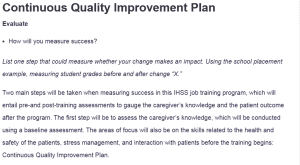Continuous Quality Improvement Plan
Evaluate
- How will you measure success?
List one step that could measure whether your change makes an impact. Using the school placement example, measuring student grades before and after change “X.”
Two main steps will be taken when measuring success in this IHSS job training program, which will entail pre-and post-training assessments to gauge the caregiver’s knowledge and the patient outcome after the program. The first step will be to assess the caregiver’s knowledge, which will be conducted using a baseline assessment. The areas of focus will also be on the skills related to the health and safety of the patients, stress management, and interaction with patients before the training begins: Continuous Quality Improvement Plan.
The second step will measure patient outcomes by assessing patient satisfaction data and examining the quality care metrics before the training (Choperena et al., 2020). The assessment will be repeated after 6 months post-training. If measurable improvements are noted, then it will be a sign of success. For example, the pre-training and post-training scores will be compared after using surveys and assessing skills. If, for instance, patient satisfaction and caregiver scores increase by 20 percent or more, then the program will be considered effective.
- How are you going to share outcomes with stakeholders?
I will present the results in the reports to share the outcomes with stakeholders. Further, one can host meetings and give the results using presentations, and at the same time, some stakeholders can get the results through digital channels (D’Souza et al., 2021). Other approaches include publishing the results in academic journals and organizing sessions to give feedback. Notably, the results will be presented differently based on the targeted stakeholders.
For instance, academic journals can be most appropriate when giving medical students and public members the outcomes. On the other hand, when presenting the outcome to doctors and nurses working in the IHSS, hosting meetings to present the outcomes is appropriate. When presenting the report, it is important to note that it should have visuals like graphs, tables, and charts.
The report should also have a description of plans for future training. This approach achieves accountability, and the program’s effectiveness is validated, thus building trust and securing ongoing support and future initiatives.
References
Choperena, A., Pardavila-Belio, M. I., Errasti-Ibarrondo, B., Oroviogoicoechea, C., Zaragoza-Salcedo, A., Goñi-Viguria, R., Martín-Pérez, S., Llàcer, T., & La Rosa-Salas, V. (2020). Implementation and evaluation of a training programme to promote the development of professional competences in nursing: A pilot study. Nurse education today, 87, 104360. https://doi.org/10.1016/j.nedt.2020.104360
D’Souza, P., George, A., Nair, S., Noronha, J., & Renjith, V. (2021). Effectiveness of an Evidence-Based Practice Training Program for Nurse Educators: A Cluster-Randomized Controlled Trial. Worldviews on evidence-based nursing, 18(4), 261–271. https://doi.org/10.1111/wvn.12521
ORDER A PLAGIARISM-FREE PAPER HERE
We’ll write everything from scratch
Question 
Evaluation stage
This is the evaluation stage.
How will you know what success looks like? How will this be measured? outline here in one statement (one sentence) what you will measure that will indicate a measurable success.

Continuous Quality Improvement Plan
Textbook link: https://enmu.instructure.com/courses/18198/files/2926285/download?download_frd=1
Note:
- Template for the assignment is attached. Thank You.
- *Also this research course requires peer reviewed journals in the last 5 years. Thanks
- My place of Internship is in home supportive services IHSS San Joaquin county Stockton, ca.
- The sector is ” Job Training” Training and Support for Caregivers: Providing ongoing training and support for caregivers can ensure they are well-equipped to handle various situations and provide high-quality care.
- This is a continuation of order #57905-CQI-A1: Assessment, order #58324- Planning Phase, and order # #58699-Action Phase.